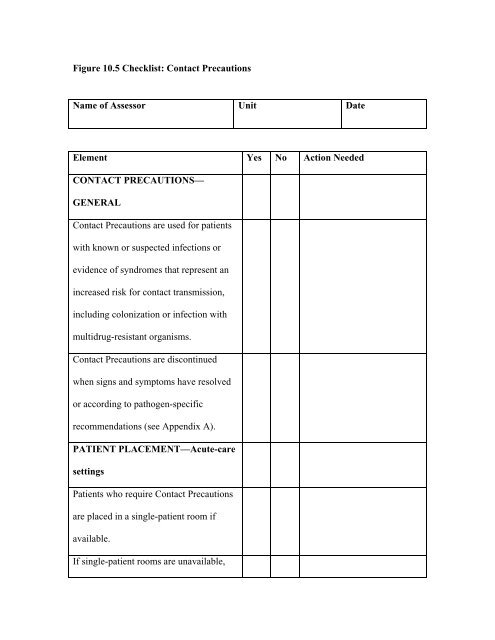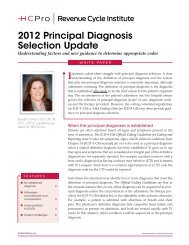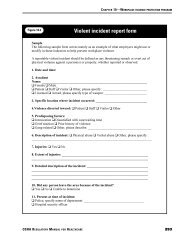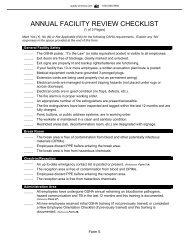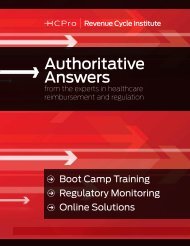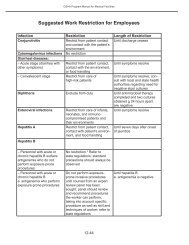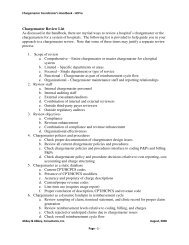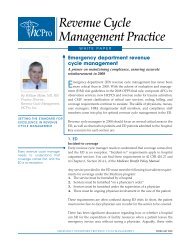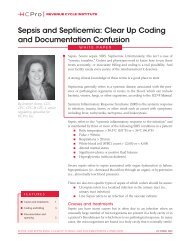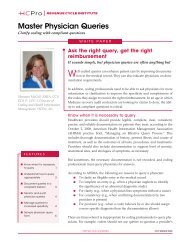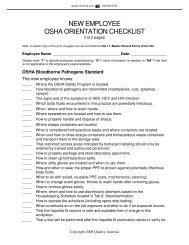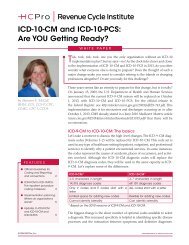CHECKLIST: CONTACT PRECAUTIONS - HCPro Blogs
CHECKLIST: CONTACT PRECAUTIONS - HCPro Blogs
CHECKLIST: CONTACT PRECAUTIONS - HCPro Blogs
Create successful ePaper yourself
Turn your PDF publications into a flip-book with our unique Google optimized e-Paper software.
Figure 10.5 Checklist: Contact Precautions<br />
Name of Assessor Unit Date<br />
Element Yes No Action Needed<br />
<strong>CONTACT</strong> <strong>PRECAUTIONS</strong>—<br />
GENERAL<br />
Contact Precautions are used for patients<br />
with known or suspected infections or<br />
evidence of syndromes that represent an<br />
increased risk for contact transmission,<br />
including colonization or infection with<br />
multidrug-resistant organisms.<br />
Contact Precautions are discontinued<br />
when signs and symptoms have resolved<br />
or according to pathogen-specific<br />
recommendations (see Appendix A).<br />
PATIENT PLACEMENT—Acute-care<br />
settings<br />
Patients who require Contact Precautions<br />
are placed in a single-patient room if<br />
available.<br />
If single-patient rooms are unavailable,
Element Yes No Action Needed<br />
the following alternatives are applied:<br />
• Single-room placement is<br />
prioritized for patients with<br />
conditions that may facilitate<br />
transmission (e.g., uncontained<br />
drainage, stool incontinence).<br />
• Patients with the same<br />
infection or colonization are<br />
cohorted in the same room.<br />
• If cohorting is done, patients<br />
are physically separated (>3<br />
feet) from each other, and<br />
privacy curtain is drawn to<br />
minimize opportunity for<br />
direct contact.<br />
• Protective attire is changed<br />
and hand hygiene performed<br />
between care of patients.<br />
• Patients on Contact<br />
Precautions are not placed in<br />
the same room with patients<br />
who have underlying
Element Yes No Action Needed<br />
conditions that may increase<br />
the risk of adverse outcomes<br />
from infection, or that may<br />
facilitate transmission (e.g.,<br />
immunocompromised, open<br />
wounds, prolonged length of<br />
stay).<br />
PATIENT PLACEMENT—Long-term<br />
care settings<br />
Decisions regarding patient placement are<br />
made on a case-by-case basis, balancing<br />
risks to other patients in the room and the<br />
potential adverse psychosocial impact on<br />
the infected or colonized patient.<br />
PATIENT PLACEMENT—<br />
Ambulatory Settings<br />
Patients who require Contact Precautions<br />
are placed in an examination room or<br />
cubicle as soon as possible.<br />
HAND HYGIENE AND GLOVES<br />
Hand hygiene and glove use are observed
Element Yes No Action Needed<br />
according to Standard Precautions and<br />
whenever there is contact with patient’s<br />
intact skin.<br />
Hand hygiene and glove use are observed<br />
whenever there is contact with surfaces<br />
and articles in close proximity to the<br />
patient (e.g., medical equipment or bed<br />
rails).<br />
GOWNS<br />
Gowns are donned whenever it is<br />
anticipated that clothing will have direct<br />
contact with the patient or potentially<br />
contaminated environmental surfaces or<br />
items in the patient’s room.<br />
Gowns are doffed and hand hygiene is<br />
performed before leaving the patient’s<br />
environment.<br />
After gowns are doffed, ensure that<br />
clothing and skin do not contact<br />
potentially contaminated environmental<br />
surfaces.
Element Yes No Action Needed<br />
PATIENT TRANSPORT<br />
Transport and movement of patients<br />
outside the room are limited to medically<br />
necessary purposes.<br />
When transport is required, it is ensured<br />
that infected or colonized areas of the<br />
patient are contained and covered.<br />
Contaminated personal protective<br />
equipment (PPE) is removed and hand<br />
hygiene performed prior to transporting<br />
patient.<br />
Clean PPE is donned when transport<br />
destination is reached.<br />
PATIENT CARE EQUIPMENT<br />
Patient care equipment is managed<br />
according to Standard Precautions.<br />
Disposable patient care items are used<br />
whenever possible.<br />
Patient-dedicated noncritical equipment is<br />
used to avoid sharing of equipment<br />
among patients.<br />
If use of common equipment or items is
Element Yes No Action Needed<br />
unavoidable, items are cleaned and<br />
disinfected before used on other patients.<br />
Home care settings<br />
Amount of patient care equipment<br />
brought into the home is limited, and<br />
when possible, equipment is left in the<br />
home until patient is discharged from<br />
home care services. Items are cleaned and<br />
disinfected if unable to leave in home.<br />
ENVIRONMENTAL MEASURES<br />
Cleaning and disinfection of the rooms of<br />
patients on Contact Precautions are given<br />
highest priority.<br />
High-touch surfaces (e.g., bed rails,<br />
doorknobs, etc.) and equipment in the<br />
patient’s immediate vicinity are cleaned<br />
frequently.


